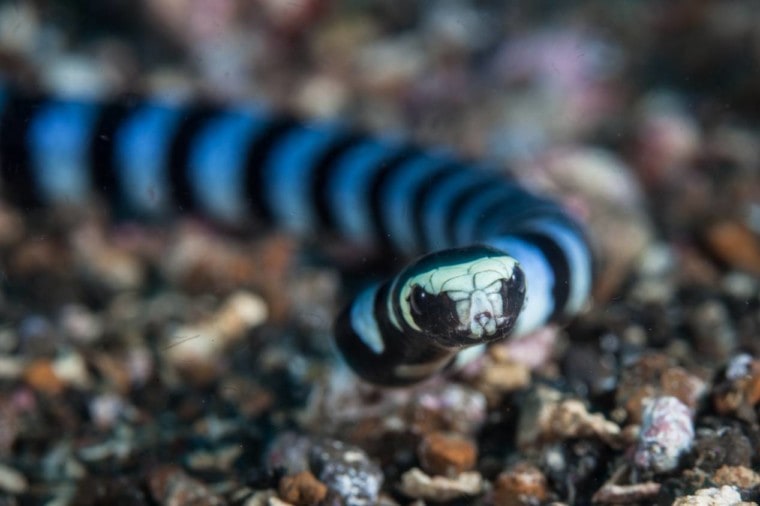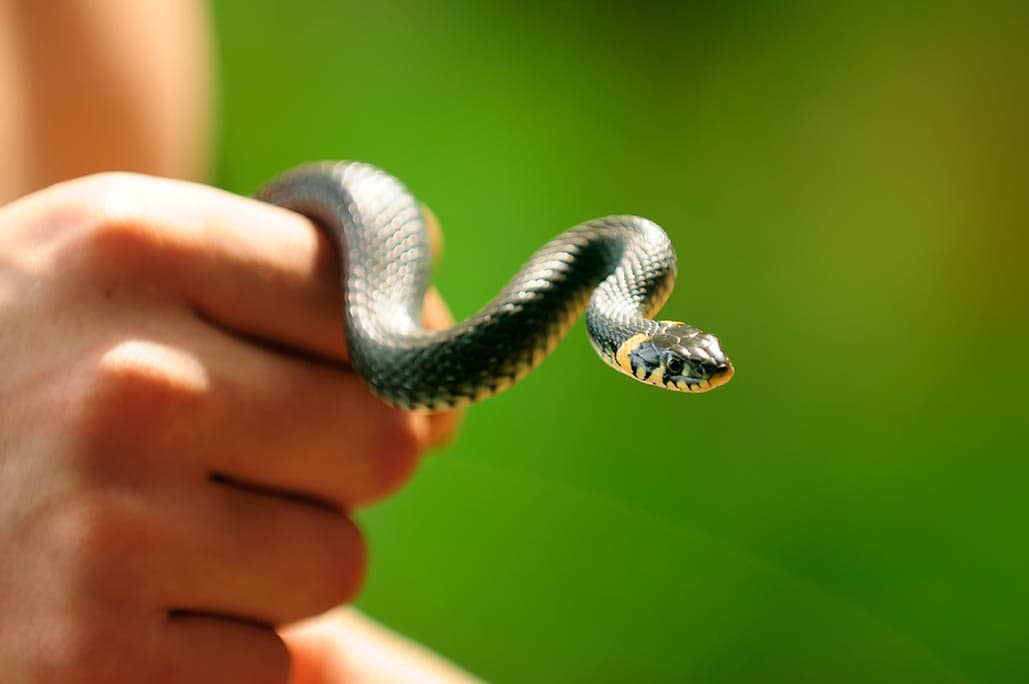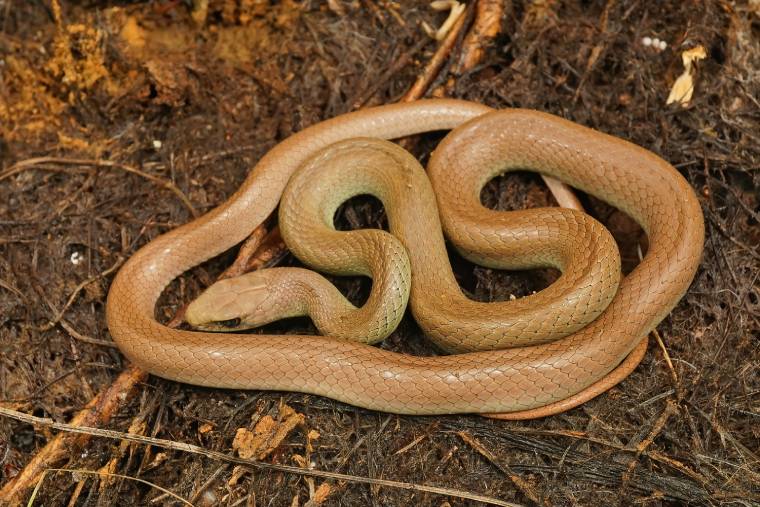
New Zealand shares a unique feature with Ireland, Newfoundland, the Antarctic, and the Arctic: None of these places have snakes—at least, not native ones. Hawaii is also snake free, and it’s considered a felony to bring one there, with a fine of up to $200,000. The reason is that local wildlife populations of these areas haven’t evolved with these reptiles and have no defense against them.
However, that doesn’t mean the country is devoid of snakes altogether. Two venomous snakes in New Zealand sometimes pay unwanted visits. Fortunately, they are not land animals, which would prove ecologically destructive. Instead, there are two species of water snakes in New Zealand.
 The 2 Snakes Found in New Zealand
The 2 Snakes Found in New Zealand
1. Banded Sea Krait

| Species: | Laticauda colubrina |
| Longevity: | Unknown |
| Good to own as a pet?: | No |
| Legal to own?: | No |
| Adult size: | 3 – 12’ L |
| Diet: | Carnivorous, primarily eels |
The Banded Sea Krait or Yellow-Lipped Sea Krait lives near the small islands of the Western Pacific and Indian Oceans. It lives in several countries in these waters, including Fiji, China, and Thailand. It only exists in New Zealand and Australia as a vagrant species. Scientists use this term to describe animals that are well outside of their typical range, most often with birds.
In this case, the ocean water may play a role in bringing the Banded Sea Krait to New Zealand. These reptiles venture on land as adults, which makes them a potent threat to wildlife. Its venom is deadly and can even kill humans. It’s not an animal that any country would welcome, let alone one where they don’t typically inhabit.
2. Yellow-Bellied Sea Snake

| Species: | Hydrophis platurus |
| Longevity: | 8 – 10 years |
| Good to own as a pet?: | No |
| Legal to own?: | No |
| Adult size: | 2 – 3’ L |
| Diet: | Carnivorous |
The Yellow-Bellied Sea Snake or Leaf-Scaled Sea Snake lives in warm and tropical ocean waters all around the world, including the seas close to New Zealand. Interestingly, the species doesn’t live in the Atlantic Ocean, presumably because it’s too cold. It prefers shallow depths, often around reefs and small islands. Little is known about this elusive animal.
Like the Banded Sea Krait, the Yellow-Bellied Sea Snake feeds on eels that it supplements with small fish. While it isn’t as large, it still poses a threat to the wildlife of New Zealand. It is a venomous snake that stuns its prey, hiding in rocks or debris. This reptile is dangerous to humans too. Since it uses currents to move, that’s likely the way that it makes it to shore occasionally.
The Absence of Snakes
You may wonder why some places don’t have any snakes, including New Zealand. Even their zoos aren’t allowed to keep them. Some areas never had snakes to begin with, for various reasons. One reason is that these cold-blooded animals have a tough time in cold places. Many snakes must burrow or find refuge in rocks during the winter.
Places like Vatican City don’t have any snakes either, though that’s less a factor of ecological isolation as it is of no habitat or prey existing there. If any snakes did make it there, they likely wouldn’t survive very long to reproduce and become a problem. Another factor is adaptability. Some snakes can live alongside humans and survive. Others, not so much.
The global distribution of snakes is also uneven. While some places don’t have them, others are overrun with them, such as the Brazilian island, Ilha da Queimada Grande. Its nickname Snake Island says it all. It has more venomous snakes per yard than any other place in the world!
Sometimes, snakes make it ashore accidentally on cargo ships. That’s what happened in Guam. Other times, the pet trade is to blame. Reptile owners might release snakes that get too big. That’s how Florida got stuck with large populations of pythons that have forced the state government to hold competitions to get rid of the invaders!
Nature plays a part in bringing sea snakes to New Zealand. It’s not an unusual occurrence for drift to provide a ride to the coast. No matter how it happens, though, it can be a problem. For example, due to the pythons, Florida has seen double-digit drops in many once-common species, such as marsh rabbits, bobcats, and raccoons.

 Conclusion
Conclusion
In a way, we can’t blame snakes for wanting to visit and perhaps live in New Zealand. It’s a beautiful country with magnificent views and scenery. However, the country doesn’t welcome these reptiles, and neither does the wildlife. After all, it’s easy to see how a stowaway or two can wreak havoc on an ecosystem. Hopefully, that won’t happen to New Zealand.
Related articles:
Featured Image Credit: Ethan Daniels, Shutterstock
 The 2 Snakes Found in New Zealand
The 2 Snakes Found in New Zealand





